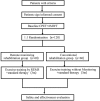Effects of home-based cardiac exercise rehabilitation with remote electrocardiogram monitoring in patients with chronic heart failure: a study protocol for a randomised controlled trial
- PMID: 30842109
- PMCID: PMC6429917
- DOI: 10.1136/bmjopen-2018-023923
Effects of home-based cardiac exercise rehabilitation with remote electrocardiogram monitoring in patients with chronic heart failure: a study protocol for a randomised controlled trial
Erratum in
-
Correction: Effects of home-based cardiac exercise rehabilitation with remote electrocardiogram monitoring in patients with chronic heart failure: a study protocol for a randomised controlled trial.BMJ Open. 2020 Jul 28;10(7):e023923corr1. doi: 10.1136/bmjopen-2018-023923corr1. BMJ Open. 2020. PMID: 32723752 Free PMC article. No abstract available.
Abstract
Introduction: Patients with chronic heart failure (CHF) can benefit from exercise rehabilitation (ER) with significant improvements in exercise capacity, quality of life and reduction in hospitalisations. Despite its reported benefits, only a small number of patients with CHF attend ER due to poor adherence, and improper exercise may even lead to adverse events. Remote ECG monitoring system (REMS) has the potential to overcome these obstacles. We hypothesise that home-based cardiac ER using REMS in CHF patients is effective compared with conventional ER without monitoring.
Methods and analysis: This study is a prospective, randomised, parallel controlled clinical trial designed to evaluate the effectiveness of home-based phase-II ER with REMS in the treatment of CHF with a target enrolment of 120 patients (left ventricular ejection fraction <50%, New York Heart Association (NYHA) classes I to III). Patients are randomised to either REMS rehabilitation group or conventional rehabilitation group in a 1:1 ratio. All patients start an exercise training in a supervised setting and then transition to a home-based regimen. The supervised training phase consists of 12 supervised training sessions, three sessions per week for 4 weeks. During the home exercise phase, patients exercise five times per week for 8 weeks. In the REMS group, patients wear monitors during exercise to ensure that exercise intensity is within the set ranges. REMS will also detect risky arrhythmia and alert the patients and their doctors on time. The training intensity is not monitored in the conventional rehabilitation group. The primary outcome is exercise capacity improvement measured by peak oxygen uptake (VO2 peak) (baseline vs 3 m). Secondary outcomes include 6-min walk test, NYHA classes, echocardiographic parameters, cardiac biomarkers, major adverse cardiovascular events, quality of life, psychological well-being and patients' adherence to the rehabilitation programme.
Ethics and dissemination: This study was approved by Ethics Committee of China-Japan Friendship Hospital for Clinical Research (No. 2018-55 K39). The results of this study will be disseminated via peer-reviewed publications and presentations at conferences.
Trial registration number: ChiCTR-RNR-17012446; Pre-results.
Keywords: cardiac exercise rehabilitation; chronic heart failure; remote electrocardiogram monitoring system; telerehabilitation.
© Author(s) (or their employer(s)) 2019. Re-use permitted under CC BY-NC. No commercial re-use. See rights and permissions. Published by BMJ.
Conflict of interest statement
Competing interests: None declared.
Figures
References
-
- Chinese Society of Cardiology of Chinese Medical Association. Editorial Board of Chinese Journal of Cardiology. Guidelines for the diagnosis and management of chronic heart failure. Zhonghua Xin Xue Guan Bing Za Zhi 2007;35:1076–95. - PubMed
-
- Chen WW, Gao RL, Liu LS, et al. . Hu SS Representative group of Chinese cardiovascular diseases report. Report on cardiovascular diseases in China (2017). Chinese Circulation Journal 2018;33:1–7.
-
- Chinese Society of Cardiology of Chinese Medical Association. Editorial Board of Chinese Journal of Cardiology. Chinese guidelines for the diagnosis and treatment of heart failure 2014. Zhonghua Xin Xue Guan Bing Za Zhi 2014;42:98–122. - PubMed
-
- Chinese Rehabilitation Medical Association Professional Committee of Cardiovascular Diseases. Committee of Cardio-Cerebral-Vascular Diseases of GSC. Chinese expert consensus on cardiac rehabilitation for patients with chronic stable heart failure. Zhonghua Xin Xue Guan Bing Za Zhi 2014;42:714–20. - PubMed
Publication types
MeSH terms
Associated data
LinkOut - more resources
Full Text Sources
Medical

